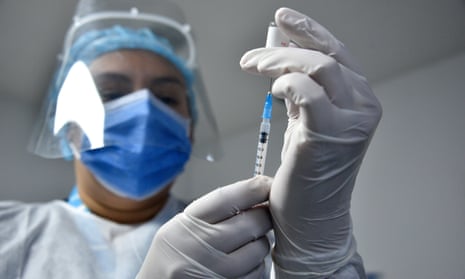Most poor countries will not achieve mass Covid-19 immunisation until at least 2024 and some may never get there, according to a new forecast, which maps a starkly divided world over the next few years in which a handful of developed countries are fully vaccinated while others race to catch up.
Countries such as the UK, US, Israel and those in the EU will probably achieve “widespread vaccination coverage” – meaning priority and vulnerable groups, and almost all of the rest of the population – by late 2021, according to analysis from the Economist Intelligence Unit. They will be followed by a slew of other developed countries by the middle of 2022 and then most middle-income countries by the end of that year.
But 84 countries that make up the world’s poorest will not receive enough doses to sufficiently immunise their populations for at least a further year, a global faultline that will run through the first half of this decade, said Agathe Demarais, the unit’s global forecasting director and author of the report.
“It’s going to define the global economy, the global political landscape, travel, pretty much everything,” she said.
Announcements beginning last December that successive vaccine candidates were safe and highly effective provided a light at the end of the tunnel, but the report released on Wednesday underscored that, in most countries, the end of the outbreak is still a year away, at least.
The key reason is the myriad hurdles in delivering doses into arms: securing vaccine ingredients, production constraints, delays in delivery, poor medical infrastructure in some countries and lack of trained health workers to administer injections, among others.
In countries such as India and China, with vast populations scattered across large landmasses, “reaching everyone in the most remote regions is going to be quite an endeavour”, Demarais said.
The forecast was put together using a model that assessed more than 200 countries based on factors including existing supply deals, production capacity, vaccine deliveries so far, infrastructure to administer doses and vaccine hesitancy rates.
High scepticism towards vaccines in Japan was a factor in why it was unlikely to achieve full immunisation this year, Demarais said.
The report was sceptical of forecasts by Covax, a global vaccine-sharing alliance, that it would supply enough doses this year to cover 27% of populations in member countries including more than 92 lower-income ones. The scheme aims to being administering vaccines next month and will announce each country’s first allocations this week.
“There’s a lot of political hope that the targets will be hit … but we can see there are already delays for production and delivery in richer countries, so we can expect some delay in poor countries,” Demarais said.
A study released on Monday found that unequal distribution of vaccines could sap more than $9tn from global GDP this year by depressing consumer demand in unvaccinated countries where normal life had yet to resume.
Ongoing lockdowns and widespread sickness would also interrupt global supply chains, with wealthier, vaccinated countries bearing about half the economic cost, the report from the International Chamber of Commerce (ICC) said. “[Sharing vaccines equitably] is not charity, it is economic common sense,” said the ICC’s secretary-general John Denton.
The WHO director-general, Tedros Adhanom Ghebreyesus, last week said the world was on the edge of a “catastrophic moral failure” in the unequal distribution of vaccines so far, with more than 40m doses given in about 50 countries, most of them wealthy or upper-middle income.
Medical rights groups have called for patents on Covid-19 vaccines and treatments to be shared so that qualified manufacturers can also begin producing them and ease global shortages. Demarais said that, even if pharmaceutical companies shared their technology, patents and knowhow, there would still be challenges in finding workers trained to produce vaccines.
“There are a number of factories now that are running out of labour supply, experienced workers who can manufacture the vaccines to sufficient quality,” she said.
